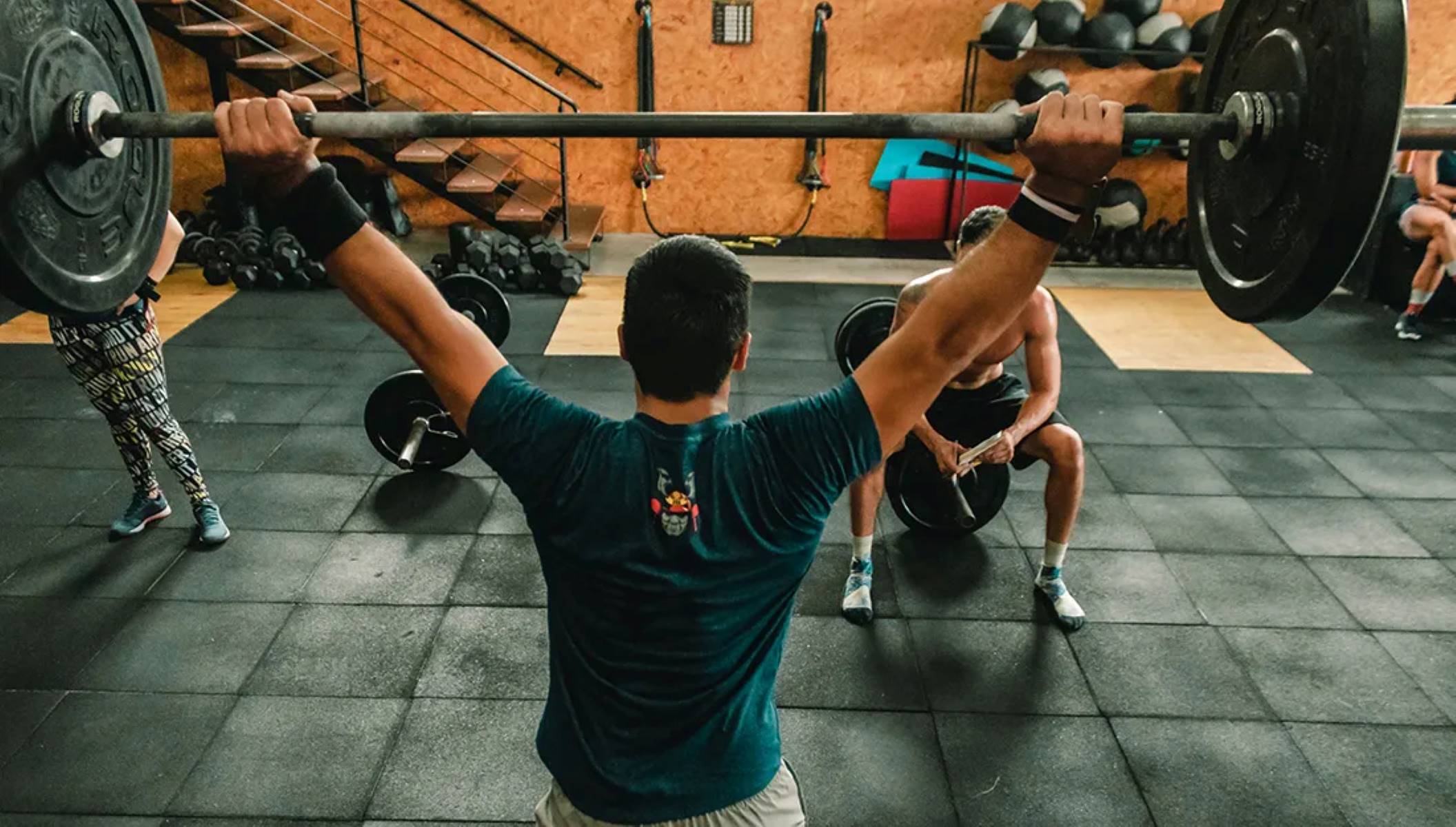

Featured
What Influences Muscular Endurance?
Modified: January 2, 2024
Discover the factors that impact muscular endurance and how to improve it. Explore our featured articles on training techniques and nutrition strategies to optimize your performance.
Introduction
Muscular endurance is a crucial component of physical fitness that plays a significant role in various activities, from everyday tasks to sports and athletic performance. It refers to the ability of a muscle or group of muscles to sustain repeated contractions or hold a contraction for an extended period. Muscular endurance is essential not only for athletes but also for individuals seeking to improve their overall fitness levels.
Understanding the factors that influence muscular endurance is essential for anyone looking to enhance their physical performance. By identifying and addressing these factors, individuals can develop effective training strategies to improve their muscular endurance and achieve their desired fitness goals.
In this article, we will explore some of the key factors that influence muscular endurance. From genetics and body composition to training programs and nutrition, we will uncover the various elements that contribute to an individual’s ability to sustain muscular contractions over an extended period. By gaining insight into these factors, individuals can optimize their training routines and maximize their muscular endurance potential.
So, whether you are an athlete looking to enhance your performance or simply someone striving to improve your overall fitness, read on to discover the factors that influence muscular endurance and how you can leverage this knowledge to reach your goals.
Definition of Muscular Endurance
Muscular endurance is a fitness concept that refers to the ability of a muscle or group of muscles to sustain repeated contractions or hold a contraction for an extended period without experiencing fatigue. It is a crucial component of physical fitness and is necessary for various activities, ranging from everyday tasks to sports and athletic performance.
Unlike muscular strength, which focuses on the maximum force that a muscle can exert in a single contraction, muscular endurance is concerned with the muscle’s ability to perform repetitive contractions over time. This endurance capacity allows individuals to maintain muscle activity for extended periods, providing the foundation for activities such as running, cycling, swimming, or even performing continuous sets of resistance exercises.
When the muscles are engaged in prolonged activity, they require a sustained supply of energy and adequate oxygen to continue contracting. The muscles also need to efficiently remove waste products, such as lactic acid, that accumulate during intense exercise. Good muscular endurance enables the muscles to withstand fatigue and continue performing optimally even under challenging conditions.
Measuring muscular endurance can be done through various exercise tests, such as push-up tests, plank holds, or timed repetitions of specific exercises. These tests assess how long an individual can sustain the activity before experiencing muscle fatigue. Improving muscular endurance involves a combination of proper training methods, adequate rest and recovery, and attention to other contributing factors.
By developing muscular endurance, individuals can enhance their performance across different physical activities and achieve greater overall fitness. It not only enables individuals to perform better in their chosen sport or recreational activities but also helps in everyday tasks such as carrying groceries or climbing stairs without getting tired easily.
In the following sections, we will explore some of the key factors that influence muscular endurance and provide insights into how they can be optimized to improve this aspect of physical fitness.
Factors Affecting Muscular Endurance
Muscular endurance is influenced by a variety of factors that interact and contribute to an individual’s ability to sustain muscle contractions over time. Understanding these factors is essential for developing effective training strategies and optimizing performance. Let’s explore some of the key factors that can impact muscular endurance:
1. Genetics and Body Composition: Genetics play a role in determining an individual’s muscle fiber composition, which can affect their muscular endurance. People with a higher percentage of slow-twitch muscle fibers tend to have greater endurance capacity compared to those with a higher percentage of fast-twitch muscle fibers. Additionally, body composition, including muscle mass and body fat percentage, can also influence muscular endurance.
2. Training Programs and Exercise Selection: The type and intensity of training programs directly impact muscular endurance. Incorporating exercises that target specific muscle groups and involve sustained contractions, such as high-repetition sets or isometric holds, can improve endurance. Progressive overload, where the intensity and volume of training increase gradually over time, is also crucial for developing and maintaining muscular endurance.
3. Muscle Fiber Type: As mentioned earlier, muscle fiber type plays a role in muscular endurance. Slow-twitch muscle fibers have a greater capacity for aerobic energy production, making them more resistant to fatigue, while fast-twitch muscle fibers are better suited for short bursts of high-intensity activity. Training can influence the distribution and characteristics of muscle fiber types to some extent.
4. Nutritional Factors: Nutrition plays a vital role in supporting muscular endurance. Consuming an adequate amount of carbohydrates provides the fuel needed for sustained muscle contractions, as glycogen stores are the primary energy source during prolonged exercise. Additionally, adequate protein intake helps repair and build muscle tissue, while hydration is essential for optimal muscle function.
5. Age and Gender: Age and gender can also impact muscular endurance. Generally, muscular endurance declines with age due to factors such as muscle loss and reduced metabolic rate. Additionally, hormonal differences between genders can influence muscle fiber composition and thus affect endurance capacity.
6. Rest and Recovery: Rest and recovery are critical for optimizing muscular endurance. Overtraining or inadequate recovery can lead to muscle fatigue and decreased performance. Allowing sufficient time for rest and incorporating techniques like active recovery and quality sleep are essential for proper muscle repair and adaptation.
7. Environmental Factors: Environmental conditions, such as temperature, altitude, and humidity, can impact muscular endurance. Extreme heat or high altitude can increase the challenge placed on muscles and lead to fatigue more quickly. It is important to adjust training and hydration strategies accordingly to optimize performance in different environments.
By considering and addressing these factors, individuals can develop comprehensive training and lifestyle strategies to enhance their muscular endurance. It is crucial to remember that each person is unique, and the importance of these factors may vary. Tailoring training programs and focusing on individual needs and goals will yield the best results in improving muscular endurance.
Genetics and Body Composition
Genetics and body composition play a significant role in determining an individual’s muscular endurance capabilities. Both factors contribute to an individual’s muscle fiber composition and distribution, which can impact their endurance performance. Let’s delve deeper into how genetics and body composition affect muscular endurance:
Genetics: Each individual has a unique genetic makeup that influences their muscle fiber type distribution. There are two main types of muscle fibers: slow-twitch (Type I) and fast-twitch (Type II). Slow-twitch muscle fibers have a higher aerobic capacity and are more resistant to fatigue, making them better suited for endurance activities. On the other hand, fast-twitch muscle fibers have a greater capacity for generating force but fatigue more quickly. Genetics partially determine the ratio of slow-twitch to fast-twitch muscle fibers in an individual’s body, influencing their endurance potential.
While genetic factors inherently impact muscle fiber composition, it is important to note that muscular endurance can still be improved through training and conditioning. Even if an individual has a genetic predisposition towards a higher percentage of fast-twitch muscle fibers, endurance-based training methods can still enhance their overall muscular endurance.
Body Composition: Body composition, specifically the ratio of muscle mass to body fat, can also affect muscular endurance. Individuals with a higher proportion of lean muscle mass tend to exhibit better endurance capabilities. This is because muscle tissue is responsible for generating force and sustaining contractions. More muscle mass provides a greater capacity for energy storage and utilization, leading to increased muscular endurance.
Conversely, a high proportion of body fat can hinder muscular endurance. Excess body fat places additional strain on the muscles and cardiovascular system. Furthermore, adipose tissue does not contribute to energy production or muscle function, making it less efficient in sustaining repeated contractions over an extended period of time.
While genetics and body composition can influence an individual’s potential for muscular endurance, it is important to remember that these factors should not discourage anyone from striving to improve their endurance. With proper training, nutrition, and dedication, individuals can optimize their muscular endurance regardless of their genetic predispositions or body composition.
By developing targeted training programs, individuals can focus on enhancing their specific weaknesses or leveraging their strengths. Incorporating progressive overload, endurance-based exercises, and proper nutrition can all contribute to improving muscular endurance, even in the face of genetic and body composition limitations.
Understanding the role of genetics and body composition in muscular endurance provides valuable insights into the potential challenges and adaptations required to optimize performance. By embracing these factors as part of the journey towards improved endurance, individuals can approach their training with a tailored and informed mindset.
Training Programs and Exercise Selection
The type of training program and exercise selection are key factors that significantly influence muscular endurance. By incorporating the right training methods and exercises into their routine, individuals can improve their endurance capacity and sustain muscular contractions for longer periods. Let’s explore how training programs and exercise selection impact muscular endurance:
Training Programs: The design and structure of a training program play a crucial role in developing muscular endurance. Endurance-focused training programs typically involve higher repetitions, lighter weights, and longer durations to promote muscular stamina. These programs aim to improve the muscles’ ability to resist fatigue and sustain contractions for extended periods.
Structured training programs should incorporate progressive overload, which involves gradually increasing the training volume (sets, repetitions) or intensity (weight, resistance) over time. This gradual progression challenges the muscles and prompts adaptation, leading to improved muscular endurance. Implementing variations in training stimulus, such as manipulating rest times or utilizing different exercise techniques, can further enhance endurance gains.
Exercise Selection: Choosing the right exercises is crucial for targeting specific muscle groups and developing muscular endurance. Endurance-based exercises typically involve sustained contractions or high repetitions. Examples include bodyweight exercises like push-ups, squats, lunges, and planks, as well as cardiovascular activities like running, cycling, swimming, and rowing.
Incorporating compound exercises that engage multiple muscle groups simultaneously can be particularly effective for improving muscular endurance. These exercises include movements like burpees, kettlebell swings, and alternating lunges with bicep curls. By involving several muscle groups, compound exercises challenge the cardiovascular system and enhance overall muscular endurance.
In addition to exercise selection, incorporating different training modalities can be beneficial. High-intensity interval training (HIIT) combines short bursts of intense exercise with brief recovery periods, effectively challenging both aerobic and anaerobic energy systems. This type of training promotes cardiovascular fitness, improves endurance, and enhances the body’s ability to recover quickly from bouts of intense exercise.
It is important to note that training programs should be tailored to individual fitness levels, preferences, and goals. A well-rounded approach to muscular endurance training should include a mix of cardiovascular exercises, resistance training, and flexibility work for optimal overall fitness.
Proper form and technique should also be emphasized during training to minimize the risk of injury and maximize the effectiveness of each exercise. Working with a qualified fitness professional or coach can provide guidance and ensure appropriate exercise selection and technique.
By designing well-structured training programs and incorporating a variety of exercises, individuals can optimize their muscular endurance and maintain consistent progress over time.
Muscle Fiber Type
Muscle fiber type is a significant factor that influences muscular endurance. Different individuals have varying proportions of slow-twitch (Type I) and fast-twitch (Type II) muscle fibers, which play a crucial role in determining their endurance capabilities. Understanding the characteristics of these muscle fibers can help individuals tailor their training strategies to optimize their muscular endurance.
Slow-Twitch (Type I) Muscle Fibers: Slow-twitch muscle fibers have a high capacity for aerobic energy production and are well-suited for endurance activities. These muscle fibers are rich in mitochondria and capillaries, which support the delivery of oxygen and sustained energy production. Slow-twitch fibers contract relatively slowly but can sustain contractions for extended periods without fatiguing easily. They are highly resistant to fatigue, making them ideal for activities that require stamina, such as long-distance running or cycling.
Fast-Twitch (Type II) Muscle Fibers: Fast-twitch muscle fibers can be further divided into two subtypes: Type IIa and Type IIb. Type II fibers have a greater capacity for anaerobic energy production and generate force more rapidly but fatigue more quickly compared to slow-twitch fibers. Type IIa fibers possess characteristics of both slow-twitch and fast-twitch fibers, making them more versatile in terms of endurance and power. Type IIb fibers are primarily responsible for explosive, high-intensity movements and have limited endurance capabilities.
It is important to note that individuals have a genetically determined muscle fiber composition, meaning they are born with a certain ratio of slow-twitch to fast-twitch fibers. While the proportion of muscle fiber types may vary between individuals, it is possible to influence their characteristics through training and conditioning.
Endurance-based training, such as long-distance running or cycling, primarily targets slow-twitch muscle fibers and promotes their growth and endurance capacity. On the other hand, explosive and high-intensity activities, like sprinting or weightlifting, predominantly engage fast-twitch muscle fibers, particularly Type IIa and IIb fibers.
However, it is worth noting that training can lead to some conversion of muscle fiber types. Resistance training with high repetitions and lighter weights can stimulate slow-twitch fiber growth and potentially contribute to an increase in their endurance capacity. This is referred to as fiber type transition or shifting, where Type II muscle fibers exhibit some characteristics of Type I fibers.
Individuals can emphasize their genetic predisposition by tailoring their training programs to suit their muscle fiber composition. For example, individuals with a higher percentage of slow-twitch muscle fibers may benefit from longer, endurance-focused activities, while those with more fast-twitch fibers might excel in explosive and high-intensity exercises.
Understanding muscle fiber types helps individuals identify their strengths and weaknesses in terms of muscular endurance. By strategically incorporating training methods that target specific muscle fiber types, individuals can optimize their training and maximize their muscular endurance potential.
Nutritional Factors
Nutrition plays a vital role in influencing muscular endurance. Proper nutrition provides the necessary fuel, nutrients, and hydration to support the muscles during prolonged activities, helping individuals maintain their endurance capacity. Several key nutritional factors contribute to optimal muscular endurance:
Carbohydrates: Carbohydrates are the primary source of fuel for muscular contractions. Consuming an adequate amount of carbohydrates, especially complex carbohydrates like whole grains, fruits, and vegetables, ensures a steady supply of energy during exercise. Glycogen, the stored form of carbohydrates in the muscles and liver, is essential for sustained muscular contractions. Adequate carbohydrate intake before exercise replenishes glycogen stores and helps optimize endurance performance.
Protein: Protein is crucial for muscle repair and maintenance. It plays a role in building and rebuilding muscle tissue, which is essential for recovery and adaptation after endurance training. Consuming enough protein, from sources like lean meats, poultry, fish, legumes, and dairy products, helps support muscle recovery and enhances muscular endurance.
Hydration: Staying adequately hydrated is vital for optimal muscular endurance. Dehydration can impair muscle function and lead to early fatigue. During exercise, individuals should aim to drink fluids regularly to maintain hydration levels. Water is generally sufficient for most individuals engaging in moderate-intensity endurance activities. However, for prolonged endurance activities or in hot and humid environments, sports drinks containing electrolytes can provide additional benefits by replenishing essential minerals lost through sweat.
Electrolytes: Electrolytes, such as sodium, potassium, magnesium, and calcium, play a crucial role in muscle function and hydration. They help maintain the balance of fluids in the body, support nerve and muscle function, and aid in nutrient transport. Ensuring an adequate intake of electrolytes through a balanced diet or sports drinks can help optimize muscular endurance.
Timing of Meals: The timing of meals and snacks can also impact muscular endurance. Consuming a balanced meal or snack containing carbohydrates and protein 1-3 hours before exercise can provide the necessary fuel and nutrients to sustain energy levels during the activity. Additionally, consuming a small carbohydrate-rich snack during prolonged endurance activities lasting more than an hour can help provide an additional energy boost.
Individual Needs: It is important to note that individuals may have different nutritional needs and preferences. Factors such as body weight, exercise intensity, duration, and goals can influence an individual’s nutritional requirements. Consulting with a registered dietitian or nutritionist can provide personalized guidance on meeting specific nutritional needs for optimal muscular endurance.
In summary, proper nutrition is essential for maximizing muscular endurance. Consuming adequate carbohydrates, protein, and fluids, as well as paying attention to electrolyte balance and meal timing, all contribute to supporting endurance performance. By fueling the body with the right nutrients, individuals can optimize their muscular endurance and enhance their overall performance.
Age and Gender
Age and gender are factors that can influence muscular endurance. Both play a role in determining an individual’s endurance capacity and their ability to sustain muscle contractions over time. Let’s explore how age and gender impact muscular endurance:
Age: As individuals age, there can be a decline in muscular endurance. This decline can be attributed to various factors, including a decrease in overall muscle mass, changes in muscle fiber composition, and a reduction in metabolic rate. Additionally, age-related changes, such as decreased collagen production and changes in hormone levels, can impact muscle function and endurance capacity.
However, it is important to note that regular exercise and strength training can help mitigate the age-related decline in muscular endurance to a certain extent. Engaging in consistent endurance-based activities and resistance training can help maintain and even improve muscular endurance as one ages. By incorporating appropriate exercises and training methods, older individuals can slow down the decline in endurance and maintain a higher level of performance.
Gender: Gender differences can also influence muscular endurance. Generally, males tend to have a higher muscle mass compared to females due to hormonal and genetic differences. This higher muscle mass can provide males with an advantage in muscular endurance. However, it is crucial to recognize that there is considerable variability within each gender, and individual training, genetics, and other factors play a significant role in determining an individual’s muscular endurance capacity.
Moreover, physiological differences, such as muscle fiber distribution and hormonal profiles, can impact endurance performance. Females, on average, have a higher proportion of slow-twitch muscle fibers, which are more fatigue-resistant and contribute to better endurance capacity. However, it is important to note that these differences should not dictate an individual’s potential for improvement in muscular endurance. With proper training and conditioning, both males and females can significantly enhance their muscular endurance regardless of gender-related differences.
Ultimately, age and gender are factors that should be taken into consideration when designing training programs and setting performance goals for muscular endurance. However, it is essential to focus on individual needs, training history, and specific objectives. By incorporating appropriate training techniques, individuals can continue to improve their muscular endurance regardless of age or gender.
It is crucial to consult with a healthcare professional or certified fitness trainer when designing training programs, especially for individuals with specific age-related considerations or gender-specific goals.
Rest and Recovery
Rest and recovery are essential factors that significantly influence muscular endurance. Adequate rest ensures that the muscles have time to repair, adapt, and replenish energy stores, allowing for improved endurance performance. Let’s explore how rest and recovery impact muscular endurance:
Repair and Adaptation: During exercise, microscopic damage occurs within the muscle fibers. Rest and recovery periods provide the opportunity for these muscle fibers to repair and rebuild themselves. This recovery process helps strengthen the muscles, leading to improved endurance performance over time. Without sufficient recovery, the muscles may not have an opportunity to adapt and could potentially lead to overuse injuries or decreased performance.
Energy Replenishment: During exercise, the body depletes its energy stores, particularly glycogen, which is the primary fuel source for muscular contractions. Adequate rest allows the muscles to replenish these energy stores, ensuring that they have the necessary fuel for sustained contractions during subsequent workouts or activities. Without proper rest and recovery, muscle glycogen levels may remain low, leading to decreased endurance capacity and early fatigue.
Prevention of Overtraining: Overtraining occurs when individuals exceed their body’s ability to recover from the physical stress placed on it. It can lead to decreased performance, increased fatigue, and a higher risk of injuries. Including sufficient rest and recovery days in a training program helps prevent overtraining by giving the muscles and the body as a whole time to rest, repair, and restore energy levels.
Sleep: Quality sleep plays a vital role in rest and recovery. During sleep, the body undergoes various physiological processes, including the release of growth hormone, which aids in muscle repair and recovery. Lack of sleep or poor sleep quality can impair these processes and hinder muscular endurance. Aim for adequate and consistent sleep to support overall recovery and optimize endurance performance.
It is important to note that rest and recovery are not limited to complete inactivity. Active recovery, which involves engaging in low-intensity activities like walking, swimming, or stretching, can also support muscular endurance. These activities promote blood flow, aid in the removal of metabolic waste products, and assist in muscle recovery without adding excessive strain to the body.
Individual Needs: The amount of rest and recovery required varies for each individual. Factors such as training intensity, duration, and individual fitness levels influence the amount of recovery time needed. Listening to the body’s signals of fatigue, soreness, and overall well-being is crucial in determining the appropriate amount of rest and recovery required to optimize endurance performance.
A well-balanced training program should include scheduled rest days, active recovery sessions, and periods of reduced training volume or intensity to allow for proper rest and recovery. By incorporating appropriate rest and recovery strategies, individuals can enhance their muscular endurance, reduce the risk of overuse injuries, and promote long-term progress and performance.
Environmental Factors
Environmental factors can significantly impact muscular endurance. The conditions in which physical activities take place can pose unique challenges and affect an individual’s ability to sustain muscle contractions over time. Let’s explore how environmental factors influence muscular endurance:
Temperature: Temperature plays a crucial role in determining endurance capacity. Extreme heat or cold can impact the body’s ability to regulate temperature, placing additional stress on the muscles. High temperatures can increase the rate of fatigue, as the body works harder to dissipate heat through sweating, potentially leading to early exhaustion. Conversely, cold temperatures can affect muscle contraction efficiency and restrict blood flow. Proper hydration, appropriate clothing, and adapting training strategies to different temperatures can help mitigate the impact of temperature on muscular endurance.
Altitude: Altitude is another environmental factor that can affect muscular endurance. At higher altitudes, the air pressure and oxygen levels are lower, which can lead to decreased aerobic capacity and endurance performance. The body adjusts to the reduced oxygen levels by increasing red blood cell production, but this adaptation takes time. Individuals transitioning to higher altitudes may initially experience decreased endurance capacity until their bodies adapt. Proper acclimatization processes, staying hydrated, and adjusting training intensity are essential when training or competing at higher altitudes.
Humidity: Humidity levels can impact muscular endurance by affecting the body’s ability to cool itself through sweating. In high humidity environments, sweat does not evaporate as easily, leading to reduced evaporative cooling and increased heat stress on the muscles. This can result in increased perceived effort and decreased endurance capacity. Individuals should hydrate adequately and consider adjusting workout intensity or duration in high humidity conditions.
Air Quality: Air quality, such as pollution or allergens, can impact respiratory function and, consequently, muscular endurance. Poor air quality can lead to respiratory irritation, compromised lung function, and reduced aerobic capacity. Engaging in physical activities in areas with good air quality or using appropriate respiratory protection when necessary are important considerations for optimizing muscular endurance.
Terrain and Elevation: The terrain on which activities take place can also affect muscular endurance. Uneven or hilly terrain can require additional effort from the muscles, increasing fatigue compared to flat surfaces. Elevation changes can also impact endurance performance. Uphill sections challenge the muscles more, while downhill sections provide some relief but introduce other challenges like impact forces and eccentric muscle contractions. Training on different terrains and adapting training programs to incorporate varied elevation can help improve overall muscular endurance.
It is crucial to consider these environmental factors when planning and executing training sessions or participating in endurance activities. Adapting training strategies, proper hydration, appropriate clothing, and monitoring overall well-being can help individuals optimize their muscular endurance in different environmental conditions.
By preparing adequately and being mindful of the specific challenges presented by the environment, individuals can overcome environmental obstacles and perform at their best in endurance-related pursuits.
Conclusion
Muscular endurance is a critical component of physical fitness that allows individuals to sustain muscle contractions over an extended period. It is influenced by a variety of factors, including genetics, body composition, training programs, muscle fiber type, nutrition, age, gender, rest, recovery, and environmental conditions. Understanding and addressing these factors can help individuals optimize their muscular endurance and reach their performance goals.
Genetics and body composition play a role in determining an individual’s muscle fiber composition, which can impact their endurance potential. While genetics and body composition are factors that individuals are born with, they can still improve their muscular endurance through tailored training programs and conditioning.
Training programs and exercise selection are key factors that influence muscular endurance. Incorporating targeted exercises and employing progressive overload methods can enhance endurance capacity and promote muscular stamina. Choosing the right exercises, such as compound movements and endurance-based activities, contributes to overall improvements in muscular endurance.
Muscle fiber type, specifically the balance between slow-twitch and fast-twitch fibers, influences endurance capabilities. While individuals are born with a certain ratio of muscle fiber types, training can lead to some conversion of fiber types and improvement in muscular endurance.
Nutritional factors, such as carbohydrate and protein intake, hydration, and electrolyte balance, play a crucial role in supporting muscular endurance. Proper nutrition provides the necessary fuel and nutrients for sustained muscle contractions during exercise.
Age and gender can impact muscular endurance, but with appropriate training and conditioning, individuals can still improve their endurance capacity regardless of these factors. Rest and recovery are essential for muscle repair, energy replenishment, and preventing overtraining, allowing for optimal muscular endurance gains.
Environmental factors, including temperature, altitude, humidity, air quality, terrain, and elevation, can pose unique challenges to muscular endurance. Adapting training strategies and paying attention to hydration and overall well-being can help individuals optimize performance in different environmental conditions.
In conclusion, by understanding and addressing the various factors that influence muscular endurance, individuals can develop effective training strategies, make informed nutritional choices, and create appropriate rest and recovery plans. By optimizing these factors, individuals can enhance their muscular endurance, improve their overall fitness levels, and excel in physical activities and sports.









